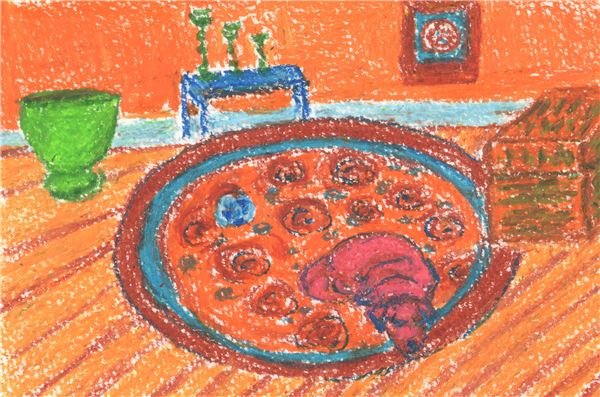Matisse Art Lesson Plan: Teaching Collage and Painting
Part of the movement known as “fauvism,” which meant “wild beasts,” Matisse emphasized color over value, which led to bold, flat designs, sometimes simplified into basic shapes so that the eye could enjoy the colors. Influenced by the flat panels of Japanese art and the shapes and patterns found in Islamic art, Matisse often spent hours carefully arranging the objects in his paintings, leading to what some saw as deceptively simple paintings.
Lesson Objective
Students will create interior compositions, arranging shapes in relation to color and pattern to create a Matisse-like feel to their works.
Materials Required
- Paper (for sketching and painting)
- Paint boards
- Pencils
- Paint (watercolor, acrylic or oil pastel, or paper cutouts)
- Brushes
- Water
- Magazines
- Scissors
- Glue
- Markers
- Reference paintings by Henri Matisse, such as “Interior with a Violin Case,” “The Dessert: Harmony in Red” and “Interior with Phonograph”
Lesson Procedure
Step One (Introduction): Introduce students to the interior paintings by Matisse, asking students to note any characteristics that stand out. Students should see that there is a lack of depth, a common theme of bright color and pattern, and carefully arranged objects. Allow time for students to discuss why they think Matisse might have painted in such a style. As an exercise, students can close their eyes after viewing a painting and think of words to describe what they remember from each piece. This should help the students understand that Matisse’s primary focus in his paintings was color.
Step Two (Collage): Students will create a collage to serve as a sample for their interior paintings. Distribute magazines (if time is a factor, you may want to provide pre-cut pictures from magazines for students to choose). Students will cut out items for their collages, focusing on objects such as furniture, windows, artwork, decorative items (vases, flowers, bowls, etc.), flooring, wallpaper, curtains, lighting and even a door if desired. You may want to assign students a number of required objects, for example:
- 1 large object (door, window with curtains, couch)
- 3-5 medium objects (small tables, chairs, artwork, small windows, lighting)
- 5-10 small objects (cups, bowls, pillows, flowers, fruit, vases, etc.).
Students should spend some time arranging objects in a pleasing style, so that the eye travels from one area of the painting to another without getting stuck. Remind students that less is more; if they feel that their arrangements are too crowded, they can remove items to simplify the composition.
Students can observe their objects for patterns. If objects do not have patterns on them, students may be encouraged to use markers to draw patterns onto them for visual interest.
Once students feel they have reached their final compositions, they can begin gluing the objects into place. The collages will serve as a guide for paintings.
Special Needs/ Skill Level Note: If you have special needs students, you can give them pre-created collages, on which the students can outline the objects with markers for practice. The collage activity also stands on its own as a good way to teach Matisse’s style without overwhelming students who have less painting and drawing experience.
Step Three (Creating the final paintings): Once collages are complete, students should feel free to begin creating their paintings. Briefly guide students in taping down paper, sketching out compositions and applying paint. To enhance the experience, you may wish to play music, as Matisse’s colorful works were created to inspire joy! Students should be careful to let paint dry if they are layering colors, so the bold, graphic nature of the colors and the patterns stays intact.
Assessment
When paintings are complete, assess how well students followed their collages and stuck to a flat painting style (without depth) that emphasizes color and pattern.
Extension
Matisse created many still-life paintings in his colorful style as well! Students who enjoyed this lesson can repeat the exercise to create still-life paintings in his style.
